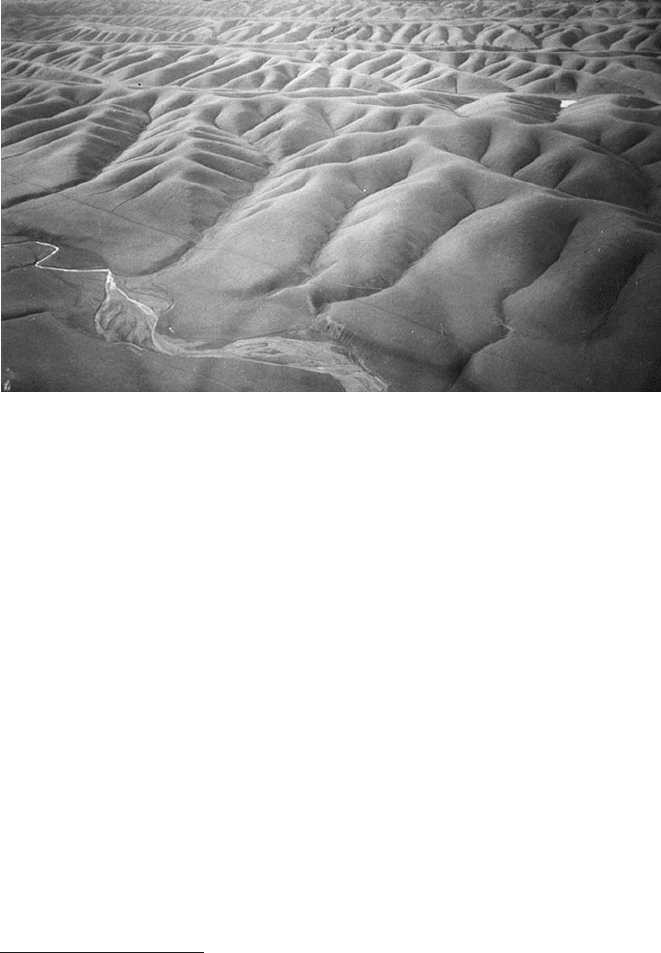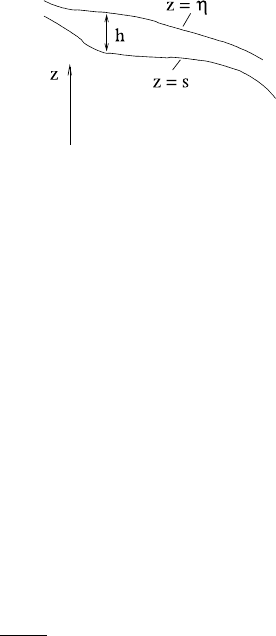Fowler A. Mathematical Geoscience
Подождите немного. Документ загружается.


330 5 Dunes
is given by
ˆ
K(k) =
(ν)exp
−
iπν sgnk
2
2π|k|
ν
for real values of k.
Now suppose that φ satisfies the evolution equation
φ
τ
+
∂
∂ξ
1
2
φ
2
+αK ∗φ
ξ
−φ
ξ
=0,
where f ∗g denotes the Fourier convolution of f and g and α is small. Show
that the steady state φ = 0 is linearly unstable, and find the wave number of
the maximum growth rate.
When this equation is solved numerically, coarsening occurs, with the
wavelength of the bedforms increasing with time. Show that if ξ ∼ L 1,
the equation can be approximated by Burgers’ equation with small diffusivity.
Hence explain the way in which coarsening occurs.
5.10 Suppose that
ψ(t) =
∞
r=0
f
r
t
r
=(1 −ξ
a
t)
−1/2
(1 −ξ
b
t)
−1/2
,
and it is desired to calculate the coefficients f
r
numerically. By consideration
of the power series for ψ
2
(or otherwise!) show that an iterative recipe for f
n
is
f
0
=1,
2f
n
=
ξ
n+1
a
−ξ
n+1
b
ξ
a
−ξ
b
−
n−1
s=1
f
s
f
n−s
.
5.11 A shear flow is described by the dimensional equation
τ =ρ
ν +κ
2
z
2
∂u
∂z
∂u
∂z
,
where ν is the kinematic viscosity. Show that a suitable dimensionless form is
τ =
ε +κ
2
z
2
∂u
∂z
∂u
∂z
,
where ε =
1
Re
, and Re is the Reynolds number. Use the method of strained
coordinates
13
(i.e., write z = s + εz
1
(s) +···, u ∼ u
0
(s) + εu
1
(s) +··· to
show that
u ≈
1
κ
ln
z +s
0
s
0
,
where s
0
=
ε
2κ
in order to suppress higher singularities in u
1
.
13
See, for example, Van Dyke (1975).

Chapter 6
Landscape Evolution
Landscape is one of the most obvious features of the environment we live in. Rolling
countryside, rugged cliffs, wind-swept mountains; the scenery which surrounds us
is formed by topography, and the shapes which the Earth’s surface is moulded into
forms the subject of geomorphology.
Topography is created by tectonic processes, and removed by erosion. The most
striking example on the planet today is the continuing formation of the Himalayas,
as India continues to crash into Asia after its separation from Antarctica during the
break up of Gondwanaland over a 100 million years ago. This continental collision
buckles the Earth’s crust and forms mountain belts; in the case of the Himalayas,
the mountains rise to a height above sea level of nearly nine kilometres, and they
are still rising.
1
Creation of mountains creates hillslope, and precipitation and its subsequent
runoff provides an erosive mechanism. At low elevations, this is through a vari-
ety of actions of running water: slow processes such as rainsplash and sheetwash,
which carry surficial sediments towards a developed stream system, in which more
rapid evacuation of sediments occurs. At higher elevations, precipitation as snow
may form glaciers, which similarly carve the landscape and erode it. Typical rates
of tectonic uplift and erosion are comparable, and very slow in stable, vegetated
landscapes: a hundred metres per million years (100 m Ma
−1
) is a typical rate for
each. In unvegetated landscapes such as badlands, erosion and gully formation can
be much more rapid.
6.1 Weathering
A necessary pre-condition for sediment removal is the break up of the basement
rock into pieces (boulders, cobbles, gravel, silt, clay: sediments of varying grain
1
The formation of the Himalayan mountains is actually more complicated than that which would
arise from a simple buckling mechanism. Geological investigations indicate that the Himalayas
are formed by a backflow of partially molten rock driven by its own buoyancy; the partial melting
occurs in the subducting Indian crust due to extremely high levels of uranium concentration.
A. Fowler, Mathematical Geoscience, Interdisciplinary Applied Mathematics 36,
DOI 10.1007/978-0-85729-721-1_6, © Springer-Verlag London Limited 2011
331

332 6 Landscape Evolution
sizes), and this is achieved through a variety of mechanisms. Mechanical weather-
ing refers to the physical disruption of rock. For example, joints and fractures are
natural consequences of rock formation; igneous rocks may have shrinkage cracks
as they cool, sedimentary rocks have bedding planes and faults formed through fail-
ure in tectonic compression. When exposed at the surface, these are subjected to
frost action and other thermally induced stresses, which break up the rock, and form
an unconsolidated regolith.
Chemical weathering refers to a variety of chemical effects which have similar
effects. Over long time scales, rain water will react with rocks. Feldspars break
down into clays (very fine grained particles) in this way, and carbonate rocks are
dissolved by weakly acidic rainwater. This is particularly noticeable in limestone,
where dissolution of the rocks can lead to the formation of spectacular underground
cave systems as found in karst regions. Chemical weathering can also form sediment
by attacking intergranular cements.
The eventual result of weathering is the rotting of rock to a decayed state called
saprolite. Further evolution of the regolith, for example, by the effects of vegetation
or through transport, leads to the formation of soils. It is the sediments of the regolith
which are subject to erosion through fluvial or glacial transport.
6.2 The Erosional Cycle
Our purpose in this chapter is to describe how the processes of tectonic uplift and
subsequent erosion can lead to the formation of the topographic patterns such as that
shown in Fig. 6.1, in which we see a typically dendritic pattern of stream channels
draining a catchment area.
The framework in which we do this is through a model which describes the evo-
lution of hillslope through the balance of the two processes, uplift and erosion. More
or less, this model will be
∂s
∂t
=U −v
A
, (6.1)
where s is the vertical height of the topography, U is the rate of uplift, and v
A
is
the rate of abrasion, or erosion, of the hillslope. Our particular approach will be to
study first the steady state of this equation, in which uplift balances erosion, and
then to seek conditions under which a uniform slope is unstable, and under which
the typical pattern of a drainage system can develop.
However, it should be pointed out that this assumption is rather an idealisation,
possible but not necessary. Another framework is the cycle of erosion described in
the latter part of the nineteenth century by W. M. Davis, thus called the Davisian
cycle of erosion.
Davis’s idea was that uplift was a relatively sudden thing, so that topography
evolved from an initial elevated stage. In a young landscape, slopes are steep and
stream erosion is strong, but as the landscape ages, slopes become gentler and ero-
sion is less dramatic. The next orogenic event initiates the next cycle, and so on.

6.3 River Networks 333
Fig. 6.1 Hillslope topography. Photograph courtesy of Gary Parker
From the modelling point of view, this framework differs from the notion of con-
tinual uplift and erosion only in detail, and there is no serious problem in using it as a
starting point. The mathematical difficulty it raises is that instability and stream for-
mation then occur on a slowly developing background state, so that an appropriate
frozen time hypothesis is required in order to determine stability criteria. Because
of the disparity of time scales between stream formation and hillslope erosion, this
is in fact hardly an issue.
6.3 River Networks
River networks are (approximate) fractals.
2
That this is so may be inferred from a
number of power-law relationships satisfied by river systems. One such is Hack’s
law, which relates the length l of a stream to its drainage basin area A,asl ∼A
0.6
.
Other power-law relationships are exhibited by quantities associated with the
Horton–Strahler ordering system, for example between the number of streams and
their order, which is an algorithmic measure of the stream size and importance
within the network.
2
A fractal set is one whose dimension is non-integral. Curves have dimension one, areas have
dimension two. A way of characterising the dimension of a set is to count the number of boxes N
of size ε required to cover the set. If N ∼ε
−D
as ε →0, then the set has fractal dimension D.This
is consistent with our intuitive sense of dimension, but also allows the calculation of non-integer
dimension for such exotica as the Koch snowflake, the Sierpinski gasket, and so on. Fractal sets
typically exhibit power-law relationships in their description.

334 6 Landscape Evolution
Fig. 6.2 Geometry of
overland flow
A question of fundamental philosophical significance is to explain how fractal
sets can arise as the response of a continuous, deterministic system to constant forc-
ing. In the study of chaotic (time-dependent) systems, the answer to this is known.
Strange attractors have fractal dimension, and this is because the systems can be
characterised by the action of (Poincaré return) maps, which generate the Cantor
sets of the attractor by a continued process of splitting and mixing. It is less obvious
how such a process might work in generating spatially fractal sets, and this appears
to remain as a challenge for nonlinear dynamicists.
6.4 Denudation Models
The basic structure of erosional theories for channel formation is typically that of a
shallow water (St. Venant) model of overland flow, coupled to an Exner type equa-
tion describing hillslope erosion. If we denote the vertical coordinate as z, and the
position of the free water surface and hillslope as η and s, respectively (see Fig. 6.2),
then a St. Venant model can be written as
h
t
+∇.(hu) =r,
u
t
+(u.∇)u =−g∇η −
f |u|u
h
.
(6.2)
These equations represent conservation of mass and momentum, and u is the mean
horizontal (or along slope) velocity. The source term r represents rainfall. The water
depth h is given by
h =η −s. (6.3)
The Exner equation to model the evolution of the hillslope s is usually taken in
the form
ρ
s
(1 −φ)s
t
+∇.q
b
=[−ρ
s
v
E
+ρ
s
v
D
]
+ρ
s
(1 −φ)U
, (6.4)
wherein φ is the bed porosity, ρ
s
is the sediment density, q
b
represents bedload
transport, and v
E
and v
D
, if present, represent erosion and deposition of sediments
(measured as velocities: see (5.44)); U would represent tectonic uplift, also mea-
sured as a velocity. The erosion and deposition terms arise when sediment can be
carried as suspended load, which is assisted by rapid flow and small particles, and
thus may be relevant in stormflow conditions. In this case the mean concentration c
of suspended sediment is given by
(hc)
t
+∇.(hcu) =ρ
s
v
E
−ρ
s
v
D
. (6.5)
v
E
and v
D
have to be prescribed, as discussed in Chap. 5.
6.4 Denudation Models 335
A possible point of confusion which arises when we study models of this type is
that some of them include down-cutting or abrasion of the landscape, while others
do not, allowing sediment to move from place to place without actually being exca-
vated: do we use (6.2)or(6.4) to evolve the hillslope? The source of this confusion
lies in the way in which the bedload transport is described. Conventionally, there
is transport but no bedload density, and this masks a conceptual awkwardness in
the models. At the outset, we address this awkwardness by modifying (6.4)inthe
following way.
We suppose that s describes the interface between stationary bed and moving
bedload, and we define a bedload density ρ
b
and bedload transport q
b
, so that
ρ
b
t
+∇.q
b
=−ρ
s
v
E
+ρ
s
v
D
+ρ
s
(1 −φ)v
A
, (6.6)
where v
A
is the abrasion or entrainment rate of the bed, measured as a velocity. The
bedload density has units of mass per unit area, and is conveniently written in the
form
ρ
b
=ρ
s
(1 −φ)a, (6.7)
where a is a length, and can be interpreted as the depth of the active deforming
bedload layer. Finally, the Exner equation is
ρ
s
(1 −φ)s
t
=−ρ
s
(1 −φ)v
A
+ρ
s
(1 −φ)U
. (6.8)
The earlier model is regained if ρ
b
→0(ora → 0), which is consistent with the idea
of bedload being a surface density. Otherwise, v
A
needs to be prescribed, in which
case it is natural to suppose it is a function of active depth a; it is this quantity v
A
which is really the down-cutting or excavation rate. It remains to be seen how small
a actually has to be in order that it be negligible; we will come back to this later.
Note that if a>0, then (6.3) must be modified to read
η =s +a +h. (6.9)
6.4.1 Sediment Transport
These equations, or generalisations of them, can be used to study some forms of
morphological instability (dunes, braiding, meandering, etc.), and this formed the
subject of Chap. 5. They also allow a description of the erosional instability mecha-
nism which is responsible for the formation of channels. The efficacy of this depends
on the chosen forms for bedload transport and bed erosion terms. The basic insta-
bility mechanism is less subtle than the stress shift analysed in Chap. 5, and is due
simply to the fact that a locally increased depth h causes increased flow u, and thus
increased erosion, which in turn allows a further increase in h.
The constituents of this mechanism involve prescription of the sediment trans-
port terms, as described in Chap. 5. Both erosion rate v
E
and bedload transport q
b
depend on stress delivered by the water flow. This stress is taken to be
τ =fρ
w
|u|u. (6.10)

336 6 Landscape Evolution
Erosion and bedload are increasing functions of τ, except that allowance needs to
be made for the local bed slope (it is easier to move particles downhill than uphill).
As discussed in Chap. 5 (see the similar discussion at (5.109)), for a particle of
diameter D
s
at the bed, the streamflow exerts a force of approximately τ D
2
s
on it,
and it is this force which causes motion. On a slope, there is an additional force
due to gravity, approximately −ρ
sw
gD
s
∇s, where ρ
sw
is the density difference
between particle and fluid. Thus the net stress causing motion is actually
τ
e
=τ −ρ
sw
gD
s
∇s. (6.11)
This slope effect will turn out to have a (crucial) stabilising effect in the equation
for s.
If the stress is below a critical yield stress, then no motion occurs, and both v
E
and q
b
will be zero. The relevant dimensionless quantity is the Shields stress,
μ =
τ
e
ρ
sw
gD
s
, (6.12)
and sediment transport or erosion occurs if μ>μ
c
≈ 0.05. The critical Shields
stress depends somewhat on particle size (through the particle Reynolds number),
but can reasonably be approximated as a constant. Denoting the dimensional yield
stress as
τ
c
=μ
c
ρ
sw
gD
s
, (6.13)
then typical assumptions for bedload transport are the Meyer-Peter and Müller rela-
tionship
q
b
=
ρ
s
K
ρ
1/2
w
ρ
sw
g
(τ
e
−τ
c
)
3/2
+
, (6.14)
where Meyer-Peter and Müller chose values of K = 8 and μ
c
= 0.047. For bed
erosion, the Van Rijn relationship is similar:
v
E
∝(τ
e
−τ
c
)
3/2
+
. (6.15)
6.4.2 Non-dimensionalisation
The variables of the model are water depth h, water velocity u, water surface η,
suspended load c, active bedload depth a, bed surface s, effective shear stress τ
e
,
and bedload transport q
b
, which is assumed to be a function of τ
e
, such as that given
by (6.14). The describing equations of the model are (6.2), (6.9), (6.5), (6.6), (6.7),
(6.8) and (6.11).
First we scale the constitutive transport terms. These are the erosional, deposi-
tional, and abrasional velocities v
E
, v
D
, and v
A
, and the bedload transport q
b
.The
erosional and depositional velocities are scaled as in Chap. 5, thus
v
E
=v
e
E, ρ
s
v
D
=v
s
cD, (6.16)
where v
e
is a typical erosion rate and v
s
is the particle settling velocity, and E and
D are dimensionless erosion and deposition rates of O(1), which are functions of

6.4 Denudation Models 337
mean flow velocity. In addition, we write
v
A
=U
D
A, q
b
=q
D
b
Q
b
, (6.17)
where U
D
is a typical value of the uplift rate U , and q
D
b
is determined by a relation
such as that of Meyer-Peter and Müller. Since we suppose that v
A
is a function of
active depth a, the choice v
A
∼U actually provides a scale for a.
We choose scales for the other eight variables h, u, η, s, c, τ
e
,aswellasx and t,
by balancing water flux with rainfall, gravitational acceleration with friction, erosion
rate with deposition rate, hillslope elevation with water surface elevation, bedload
transport with abrasion rate, and hillslope rate of change with both abrasion rate and
tectonic uplift (if this is present). If we suppose that d is a suitable hillslope height
scale and l is a suitable horizontal length scale, then we specifically choose
η, s ∼d, x ∼l, t ∼[t]=
d
U
D
,τ
e
∼fρ
w
[u]
2
,
u ∼[u]=
gr
D
d
f
1/3
,c∼
ρ
s
v
e
v
s
,h∼[h]=l
fr
2
D
gd
1/3
,
(6.18)
where we take r
D
as a typical precipitation rate.
There appears as yet to be nothing to constrain the length and depth scales l
and d. The first of these might be determined by the implied tectonic setting. The
simplest conceptual idea is the continuing uplift of an island (or a mountain belt),
with sea level fixed at prescribed boundaries, and this determines a natural length
scale l, the scale of the island. The other scale is fixed by the balance of uplift rate
with hillslope denudation, which requires
l =
q
D
b
ρ
s
(1 −φ)U
D
. (6.19)
This appears to determine l again, but in fact it determines d through the dependence
of q
D
b
on τ
e
and thus [u]. For example, if we take q
D
b
∝ τ
3/2
e
∝[u]
3
, then from
(6.18), we have q
D
b
∝d, and thus d ∝U
D
l.
3
Using the scaled variables in the model equations (6.2), (6.3), (6.5), (6.6) and
(6.8), we obtain the dimensionless set
δεh
t
+∇.(hu) =r,
δF
2
δεu
t
+(u.∇)u
=−∇η −
|u|u
h
,
η =s +δh +δνa,
δε(hc)
t
+∇.(hcu) =γ(E−cD),
δνa
t
+∇.Q
b
=−α(E −cD) +A,
s
t
=−A +U,
τ
e
=|u|u −β∇s,
(6.20)
3
More precisely,
d
l
∼(
ρ
sw
(1−φ)
Kf
1/2
ρ
w
)
U
D
r
D
∼
U
D
r
D
, so high mountains are (in this theory) a consequence
of high uplift rate and low rainfall, which makes intuitive sense.

338 6 Landscape Evolution
and we suppose for the moment that
Q
b
=f(τ
e
)N, (6.21)
where
N =
τ
e
τ
e
, (6.22)
and f is no longer used for the friction factor.
4
The parameters are defined by
ε =
U
D
r
D
,δ=
[h]
d
,F
2
=
[u]
2
g[h]
,β=
ρ
sw
D
s
ρ
w
[h]
,
γ =
v
s
r
D
,ν=
[a]
[h]
,α=
v
e
(1 −φ)U
D
,
(6.23)
[a] being the scale for the active depth a. The definitions of ε and Froude number
F here correspond to those used in Chap. 5.
It is easy to get a sense of the size of the various parameters in the model, simply
from observation. We have seen in Chap. 5 that ε 1, and this is confirmed in the
present case; if, for example, we take U
D
∼ 10
−3
my
−1
(1 km per million years)
and r
D
∼1my
−1
, then ε ∼10
−3
.
The important parameter δ is the ratio of stream depth to hillslope height, and
is small. An estimate for [h] based on values r
D
∼ 1my
−1
, L ∼ 10
5
m, f ∼ 0.1,
g ∼ 10 m s
−2
, d ∼ 10
3
m, is [h]∼2 cm, thus δ ∼ 10
−5
, and even in stormflow
conditions, a transient depth of as much as a metre yields δ ∼ 10
−3
. Note that for
this choice of d and U
D
, the (erosional) time scale is a million years.
The velocity scale corresponding to the above depth is 0.2 m s
−1
, and from this
we calculate that the Froude number is about 0.4. This is quite vigorous, indicative
of the implicit assumption of relatively bare (and thus smooth) ground. Generally,
overland flow will have quite small Froude number, except in stormflow conditions;
even then, the Froude number does not greatly exceed unity.
The erosional parameters are γ , α and ν. Since bedload transport typically occurs
over an active depth of at most a few grains, we can safely assume that ν 1.
The particle settling velocity is given by (5.8), which dimensionally gives v
s
∼
[D
s
]
2
ms
−1
if D
s
=[D
s
] mm. Thus v
s
is typically quite large, and consequently γ
is large; a typical estimate is (for particle grain size 1 mm) γ ∼ 10
7
. Estimates for
v
e
are about 10
−2
v
s
, since typical suspended loads ρ
s
v
e
/v
s
are of order 10 g l
−1
,
and for U
D
∼10
−3
my
−1
,wehaveα ∼ 10
8
1.
Approximately, β ≈D
s
/[h] 1; we will thus generally take β =O(1).
In summary then, we estimate
ε, δ 1,
F
2
,ν,β 1,
γ, α 1.
(6.24)
4
It is an unfortunate feature of applied mathematics that there are not enough letters in the Roman
and Greek alphabets, even allowing for capitals, overhats, tildes, asterisks, subscripts and super-
scripts. Duplication is inevitable, and here, apologetically, we use f for the dimensionless sediment
transport function, having just made use of it as the friction factor.
6.5 Channel-Forming Instability 339
6.4.3 The Issue of Time Scale
The sceptical reader will at this point enjoy some doubts about these ‘typical’ val-
ues. A first obvious point is that for a supposed typical overland flow depth of 2 cm,
the turbulent friction law (6.10) may not be appropriate. This is, in fact, easily mod-
ified by allowing a laminar component of stress at low Reynolds number, but this
is a cosmetic component which does not alter the structure of the model (see also
Question 6.2).
A more subtle concern is illustrated by the size of the Froude number. The fact
of the matter is that it does not rain all the time, but in occasional showers and
storms, and furthermore, we might expect that erosion and bedload transport would
hardly occur, except in the most severe storms. Since our erosional time scale is
[t]=d/U ∼ 10
6
y, it seems likely that the principal erosion forming events are
such extremely rare storm-induced floods, and that during these, the Froude number
may be O(1) or higher. This raises the concern that the estimation of the parameters
on the basis of typical ‘average’ values may be inappropriate.
For example, consider a landscape where is there is an extreme storm for a day
every 100 years, and drought at other times (and ignore the fact that this would
actually be a desert). In this scenario, water flow and erosion only occur during the
storm, and the intervening century is irrelevant for the purpose of calculating water
flux and erosion. It then becomes appropriate to use a different time scale (and thus
also water depth and velocity scales) to describe the erosive effect of the storm. The
evolution of the topography over longer tectonic time scales then occurs through the
aggregation of these short time scale discrete erosional events. It is not obvious that
averaging in this way (i.e., solve the short time erosional problem and then average
over time) yields the same result as the approach we have taken (i.e., average over
time and then solve the erosional problem), but we shall proceed on this basis, partly
because it may well be appropriate in certain (e.g., temperate) environments, and
partly because this is the approach which has implicitly been taken in the literature
of the subject. Further consideration of this point is consigned to the exercises.
6.5 Channel-Forming Instability
The basic problem in understanding the development of river networks is the forma-
tion of a channel from a uniform overland flow. To see how this can happen, we will
begin by considering a simplified version of the model equations (6.20). We assume
δ 1, ε 1, F
2
1, ν 1, and ignore the corresponding terms in the equations.
The last of these (neglect of the term δν in (6.20)
5
) corresponds to the neglect of the
bedload density ρ
b
, even in the stormflow case where a significant active layer may
be mobilised.
We also make the important assumption of supposing that sediments are coarse,
and are transported only as bedload, so that v
E
=0 and thus also c =0. This avoids
the issue of dealing with the large parameters γ and α (see also Question 6.4). With
